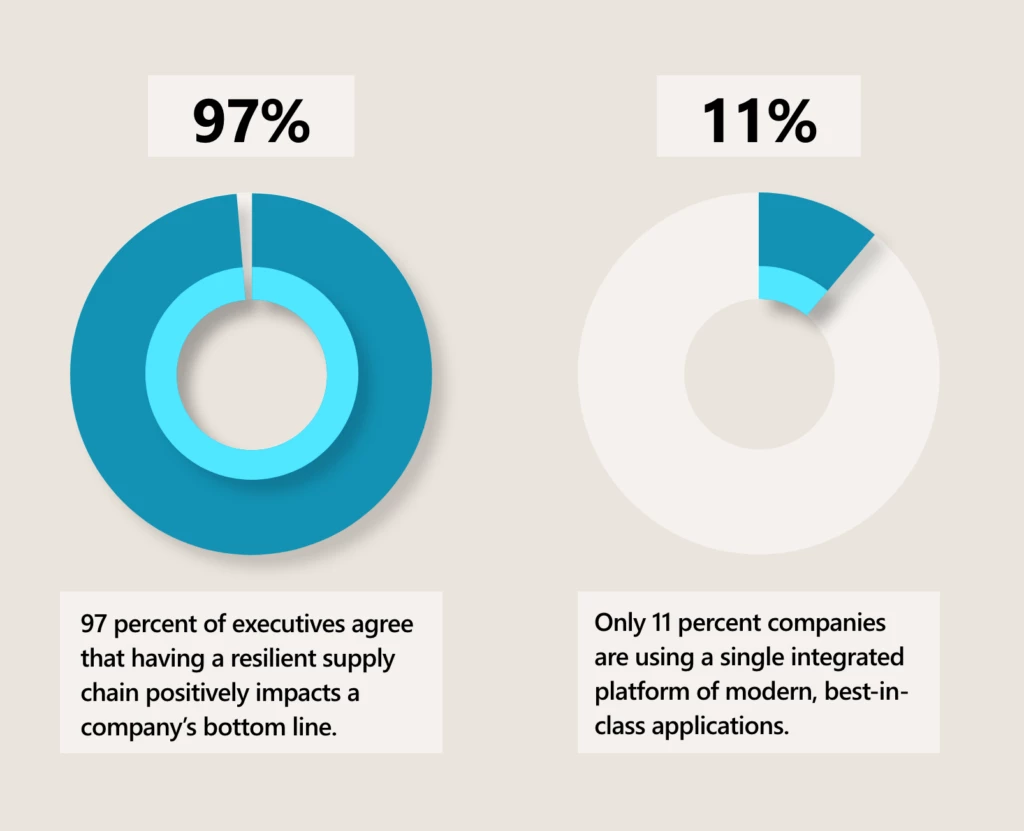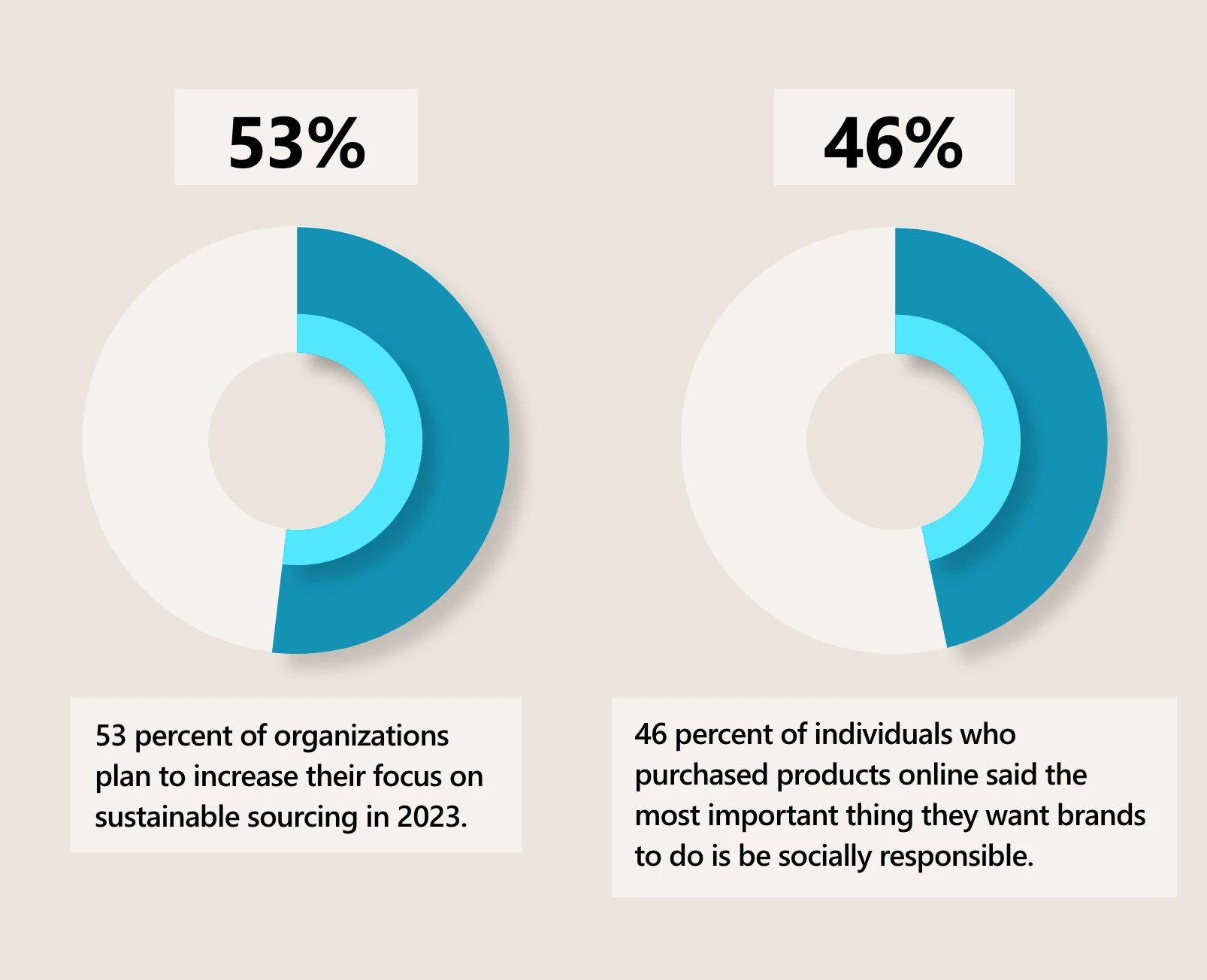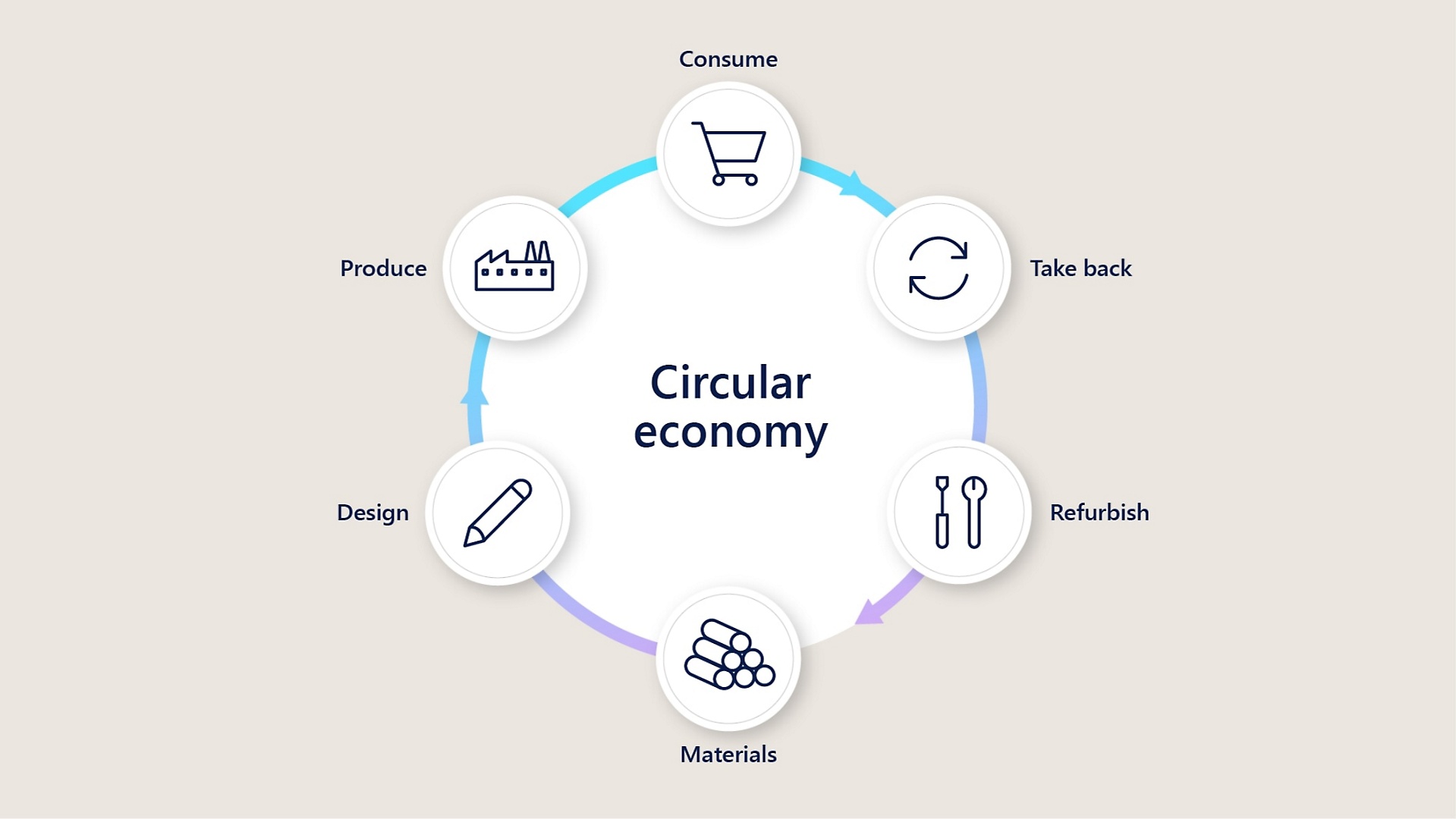Resiliency for retailers might best be understood by thinking about the delight consumers feel when they order that specific, thoughtful gift online for the holidays or when they come across the perfect gift while shopping at a store. To be successful with consumers in these moments, retailers must have the right products in stock at the right time and deliver them quickly and cost-effectively. This is what resiliency for retailers looks like, but how do you build resiliency into your supply chain?
Microsoft Supply Chain Center
Reduce supply and demand mismatches by running simulations using AI and real-time, advanced analytics.

McKinsey & Company found that 75 percent of consumer packaged goods (CPG) supply chain leaders prioritize supply chain digitalization, suggesting that resiliency through digitalization is one strategy that retailers are exploring.1 At Microsoft, we believe the path to retail resiliency lies in three interconnected capabilities: connectivity, agility, and sustainability, which we showcase solutions around at this year’s National Retail Federation (NRF) exposition in New York City.

Connectivity
True end-to-end visibility requires a platform capable of connecting and harmonizing data from new and existing sources. According to research commissioned by Microsoft from Harvard Business Review Analytic Services, 97 percent of executives agree that having a resilient supply chain positively impacts a company’s bottom line.2 The same study found that most organizations’ digital infrastructure is composed of a mix of modern and legacy apps, with only 11 percent using a single integrated platform of modern, best-in-class applications.3 This makes any solutions’ connectivity a critical factor in building resilience and agility.
One merchant that is enjoying the benefits of connectivity and visibility is iFIT. iFIT is a leading health and fitness platform that markets several home exercise equipment brands. Recently, iFIT adopted the Microsoft Supply Chain Platform to bring together its systems and data. With this integrated, centralized view, iFIT can reduce the manual effort and guesswork involved in strategically placing inventory in its more than 40 forward-stocking locations. Utilizing built-in AI capabilities, iFIT increased efficiency from 30 to 75 percent on their forward stock inventory resulting in faster delivery times––reduced from a two-week window to two days––and increased customer delight.
Extensible systems increase connectivity, too, such as the ability to leverage highly functional micro-services like the Inventory Visibility Add-in for Microsoft Dynamics 365 Supply Chain Management. Users can enable the Inventory Visibility service free of charge to gain a real-time, global view of on-hand inventory and tracking across all data sources and channels. Additionally, the Inventory Visibility service allows users to avoid overselling by making real-time soft reservations and using the allocation feature to ring-fence valuable on-hand stock for essential customers or channels.
Learn more with the Inventory Visibility Add-in overview.
Another dimension of connectivity is collaboration. Dynamics 365 and Supply Chain Center include Microsoft Teams built-in, unleashing the power of collaborative applications for users, making all your business processes and applications multiplayer. With collaborative applications, team members can connect in real time, surface and act on insights from unified data, and swarm around supply chain issues to mitigate disruptions before they impact customers.
Connected systems and data create the visibility supply chains need to sense risks and illuminate opportunities––the necessary precursors to agility, which we look at next.
Agility
To enable agility, supply chain software needs to increase visibility across data sources, predict and mitigate disruptions, streamline collaboration, and fulfill orders––sustainably and securely. In short, companies need to understand the entire supply chain network. By connecting disparate systems and harmonizing data across the supply chain, companies gain a more comprehensive understanding of supply and demand. With Supply Chain Center, retailers can connect and harmonize data and generate supply and demand insights using AI to uncover patterns and projections based on historical and real-time inventory and order volumes.
One company using Supply Chain Center to build a more agile supply chain is Northern Tool + Equipment, a manufacturing and omnichannel retailer with 130 stores across the United States. Northern Tool + Equipment’s fragmented supply chain technology infrastructure had pushed lead times for the 100,000 items in its product catalog to four to seven days. In addition, many of the company’s products are very large, like generators and air compressors. The sheer size of these items brings further complexity to the challenge of optimizing shipping routes for cost and sustainability. Similarly, Northern Tool + Equipment struggled to provide firm delivery dates for online and in-store product orders. For a business that serves people who do tough jobs and rely on their tools for their livelihood, being competitive means offering delivery in one to three days and providing accurate delivery times.
Northern Tool + Equipment partnered with Microsoft to overcome these challenges with an end-to-end supply chain solution. The selection of Supply Chain Center meant that Northern Tool + Equipment could immediately begin to rationalize and connect every node of its supply chain with a solution designed to create a more resilient and sustainable supply chain through an open, flexible, collaborative, and secured platform. The result? Northern Tool + Equipment can provide customers with a committed delivery date and shipping costs while also ensuring one-day to two-day delivery within a specific proximity of its stores.
A significant factor in Northern Tool + Equipment’s lead time improvement is its use of Microsoft Dynamics 365 Intelligent Order Management capabilities, which allows organizations to connect and orchestrate order fulfillment across different platforms and apps. But Supply Chain Center has an assortment of capabilities to serve other retailers on the agility journey.
One such capability is the Supply Chain Center news module, which gathers information about world events and presents articles relevant to your business and supply chain. How can this feature be a functional building block of agility?
Let’s consider an example of a retailer selling portable air conditioners. Using the news module, the retailer could receive a news alert that a specific geography is forecasted to have the hottest summer on record. This would likely increase the expected seasonal demand for the product in the affected region. The retailer could capitalize on this intelligence by increasing their forecast during the planning process so that they can be prepared to quickly shift inventory to ensure coverage.
In addition, Supply Chain Center connects with Microsoft Dynamics 365 Supply Chain Management, which gives retailers access to advanced warehouse management functionality, such as warehouse automation by integrating with partners like inVia Robotics. It also gives retailers the ability to set up pop-up warehouses in a matter of days in six easy steps. Continuing the example above, our portable air conditioner retailer might utilize the supply chain planning functionality and learn that they have insufficient warehouse capacity to meet the seasonal demand increases. In this case, they could use Dynamics 365 Supply Chain Management to open a new warehouse in a matter of days by utilizing wizards and templates and quickly deploying the mobile app. Similarly, the retailer could then improve warehouse productivity with InVia Robotics by leveraging robots to do the heavy lifting and traveling across the warehouse, freeing up workers to do the more complex task of sorting and packing. The value of these systems is getting the attention of organizations and analyst firms. Gartner® predicts that by 2026, 75 percent of large enterprises will have adopted some form of intralogistics smart robots in their warehouse operations.4
Sustainability, circular economies
In a recent survey, 46 percent of individuals who purchased products online said the most important thing they want brands to do is be socially responsible.5 This fact helps explain why 53 percent of organizations plan to increase their focus on sustainable sourcing in 2023.6 While there are several dimensions of social responsibility, sustainability is the most relevant to retail supply chain leadership. For retail supply chains, this can be challenging.

For retailers to lead not just the industry but to exceed consumers’ expectations for social responsibility, another challenge beckons—the utilization of circular economies. Even leaders in the EU, who successfully decreased material use by 9 percent and increased products derived from recycled waste by 50 percent,7 understand that while their progress is impressive, growth of circular economies is still limited compared to their actual material footprint. Still, the incentive for retailers, beyond the value of doing the right thing, is significant. One survey by Statista expects worldwide revenue of circular economy transactions to more than double from 2022 to 2026, growing from $338 billion to $712 billion.8

One way that Microsoft is helping brands meet the challenge is with built-in sustainability features for suppliers. One example is the FedEx integration with Intelligent Order Management––which is included in Supply Chain Center. The FedEx integration allows users to offer boxless returns to their customers by leveraging environmentally friendly QR codes to return items at more than 60,000 retail FedEx locations. Plus, retailers can utilize the self-service return functionality of the FedEx integration to easily manage all returns with complete visibility of every step in an item’s return to the warehouse.
Learn how FedEx and Dynamics 365 reimagine commerce experiences.
What’s next?
As we have seen here, the path to retail resilience in today’s competitive environment revolves around connectivity, agility, and sustainability. Brands should address disruptions and challenges with solutions that can exceed customer expectations, drive profitability, and improve sustainability.
Ready to see how Supply Chain Center can help your business on the path to retail resiliency? Watch our Supply Chain Management guided tour and sign up for a free 180-day trial of Microsoft Supply Chain Center (preview).
For a look back at NRF 2022, check out our previous blog: Dynamics 365 helps build the retail supply chain of the future. And take a look at the following posts to learn more about NRF 2023:
- Transform retail customer experiences with the Microsoft Customer Experience Platform
- Resilient Retail
- How Microsoft Teams empowers your retail workers to do more with less
Sources
1McKinsey & Company, 2022. How consumer-packaged-goods companies can drive resilient growth.
2Harvard Business Review Analytic Services, 2022. A Supply Chain Built for Competitive Advantage.
3Harvard Business Review Analytic Services, 2022. A Supply Chain Built for Competitive Advantage.
4 Gartner, 2022. Gartner Predicts the Future of Supply Chain Technology. GARTNER is a registered trademark and service mark of Gartner, Inc. and/or its affiliates in the U.S. and internationally and is used herein with permission. All rights reserved





